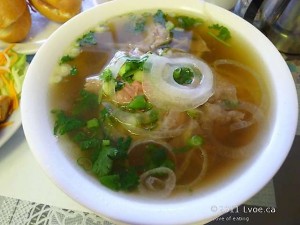Pho, this is the most wonderful soup in the world. I eat the vegetarian version at least once a week (I am sure that even the vegetarian soup is made with the beef broth they make, I haven’t asked but it is so good I just don’t think about it) with plenty of hot peppers in it.
What Is Phở?
The origin of phở is uncertain, and is mostly culled from oral histories. While a distinctly Vietnamese dish, phở has French and Chinese influences. Still, the consensus among academics, diners and restaurateurs is that it originated in the early 20th century in northern Vietnam. The specific place of origin appears to be southwest of Hanoi in Nam Dinh province, then a substantial textile market, where cooks sought to please both Vietnamese (with local rice noodles, of Chinese origin) and French tastes (cattle before the French arrival being beasts of burden, not frequently sources of beef). It was first sold by vendors from large boxes, until the first phở restaurant was opened in the 1920s in Hanoi.
Phở gà at a typical phở street stall in Hanoi. Note the lack of side garnishes, typical of northern Vietnamese-style phở
Street vendor pho ga Hanoi. Wikipedia Photo.
The origin of the word was one subject in a seminar on phở held in Hanoi in 2003. One theory advanced there is that the name comes from the French feu (fire), as in the dish pot-au-feu, which like phở uses the French method of adding charred onion to the broth for color and flavor, one of the techniques that distinguishes it from other Asian noodle soups. Some believe the origin of the word to be the Chinese fen (粉). In addition to rice noodles, multiple spices (such as star anise and cinnamon) are staples of Chinese cuisine (although the cinnamon used in phở, Saigon cinnamon, is not a true cinnamon and is a local ingredient).
Linguistically, the etymology of the name is not likely to be French. In the Vietnamese language, the word phở carries a non-flat category, whereas most French loanwords carry a flat tone, sắc or nặng tone, depending on the end consonant except loanwords that end with -t, -p, -c or -ch. Phở does not match this rule.
Some observers believe phở may come from the Cantonese rice vermicelli hofan (河粉), which are interchangeably abbreviated as either fan2 (粉, phấn in Tự Hán Việt) or Ho2 (河, Hà inTự Hán Việt ), the two sounds giving the name “phở”. Both fan and pho refer to the same rice noodles found in Vietnam and Guangdong, China, suggesting rice noodles may have been brought to Vietnam by Cantonese immigrants from the Guangdong province in the early 20th century. The noodles are cooked the same way in both places and are often seasoned with fish sauce, garnished with bean sprouts, and served with meatballs and sliced beef. Vietnamese phở, however, is further garnished with fresh mint, cilantro (coriander leaves), basil, bean sprouts, limes, sliced chili peppers and sliced raw beef; this is especially true of Saigon-style phở. Furthermore, the broth of phở is made of beef bones and fresh onion, whereas the Cantonese broth of fan is made of dried flatfish and other seafood. In some regional varieties, the Vietnamese broth may also have a mildly sweet flavour from Asian yellow rock sugar, but the Cantonese version is not.
The variations in meat, broth and additional garnishes such as lime, bean sprouts, ngo gai (culantro), hung que (Thai/Asian basil), and tuong (bean sauce/hoisin sauce) appear to be innovations introduced in the south. Phở did not become popular in South Vietnam until 1954.
If you haven’t tried this soup you should, there are good Pho restarants and some not so good, you may want to ask around. I don’t think you will be disappointed.
Donna
skype: donna.james571
Donna Ruck
Latest posts by Donna Ruck (Posts)
- xango - July 14, 2013
- New Beginnings - July 12, 2013
- Long time since I have done a post. So sorry. - July 9, 2013
- Parents, Children, Pets and Germs - May 19, 2013
- Dolphin Therapy for Autism - May 19, 2013



